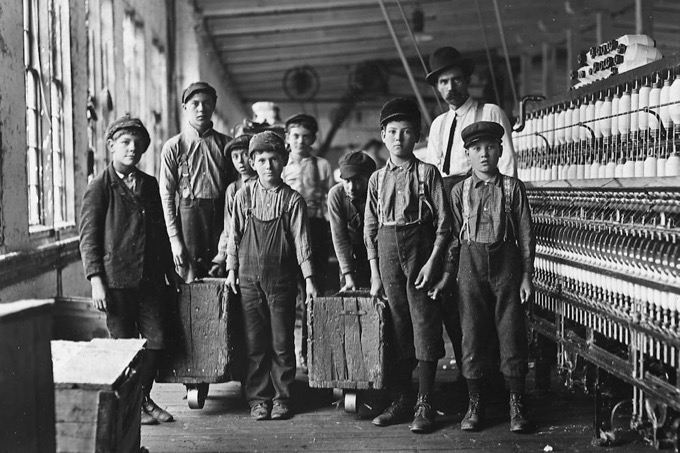
REMEMBERING THE IMPORTANCE OF THE LABOR MOVEMENT: Sociologist Lewis Hine took this photo in 1908, showing some of the doffers with their superintendent. A doffer tended the spindles on the machine, removing full ones and replacing them with empty spools; ten small boys and girls about this age would be employed in a force of 40 employees. Catawba Cotton Mill. Newton, N.C.
MONDAY, SEPTEMBER 4: Now that COVID fears are fading, millions of Americans are on the road for this big holiday weekend that marks the end of summer. According to AAA’s annual Labor Day travel forecast: “As summer winds down, many Americans are heading out of town. AAA booking data for flights, hotels, rental cars, and cruises shows Labor Day weekend travel is up over last year: domestic bookings are up 4% and international bookings are up 44%.”
Based on the booking data from AAA-assisted travelers, the top five international destinations this year are Vancouver, Rome, London, Dublin and Paris. The top five U.S. destinations for travelers requesting AAA assistance are Seattle, Orlando, Anchorage, New York and Las Vegas.
Closer to home, of course, millions of Americans will enjoy parades, fireworks, jam-packed picnic grounds and lots of back yard barbecues.
Got extra time? Learn the history …
This year, in particular, educators, labor leaders and historians are urging Americans to use their extra time to look back at the history and relevance of labor in the lives of American workers.
Our opening photo, above, is one of many preserved by sociologist Lewis Hines. Consider creating your own Labor Day-themed media. You could share a message with friends on social media—or perhaps put together a discussion for your small group or class. Wikimedia Commons provides many of Hine’s classic images that you are free to use.)
At the end of the 19th century, many Americans had to work 12-hour days every day of the week to make a living. Child labor was at its height in mills, factories and mines, and young children earned only a portion of an adult’s wage. Dirty air, unsafe working conditions and low wages made labor in many cities a dangerous occupation. As working conditions worsened, workers came together and began forming labor unions: through unions, workers could have a voice by participating in strikes and rallies. Through unions, Americans fought against child labor and for the eight-hour workday.
Labor Day is the result of the long struggle for recognition of workers’ rights by the American labor movement.
Some labor demonstrations turned violent—such as the Haymarket Riot of 1886, which is remembered, to this day, in May 1 labor holidays around the world. Instead of a May holiday, however, American leaders preferred to remove “our” holiday from that tragedy by four months, in the civic calendar. Instead, American holiday planners encouraged street parades and public displays of the strength and esprit de corps of the trade and labor organizations in each community—including cheerful festivities and recreation for workers and their families.
Oregon became the first state to declare Labor Day a holiday, in 1887, and by 1896, Labor Day was a national holiday.
Religious Leaders Weigh In …
The value of human labor is echoed throughout the Abrahamic tradition, including stories and wisdom about the nature of labor in both the Bible and the Quran. Biblical passages ask God to “prosper the work of our hands” (Psalm 90), while the Quran refers to the morality of conducting oneself in the public square.
The Catholic church has been preaching on behalf of workers for more than a century. The landmark papal encyclical Rerum Novarum (“Of revolutionary change”) was published in 1891 and has been described as a primer on the rights of laborers who face abusive conditions in the workplace. This became one of the central themes of Pope John Paul II’s long pontificate. In 1981, he published his own lengthy encyclical, Laborem Exercens (“On human work”). Then, a decade later, John Paul returned to this milestone in Catholic teaching in Centisimus Annus (“Hundredth year”).
In 2019, the United Methodist Church published an appeal to church leaders. Titled “Labor Day Is Not Just a Day Off,” the text says in part:
Did you know The United Methodist Church has been a part of the labor movement throughout history and is committed to fairness and justice in the workplace? In the early 20th century the church was working to end child labor. And in the ’50s, during our country’s civil rights movement, we were fighting for fair wages and better working conditions. We were dedicated to fairness and justice in the workplace then, and we still are today.
When John Wesley founded the Methodist movement during the 18th century, there was no “worker movement” the way we’d understand it today. But Wesley preached to and cared for coal miners and other oppressed workers. He also opposed slavery. After Wesley died, his followers continued to work against workplace injustices in rapidly industrializing England, adopting the first Social Creed, in 1908, that dealt exclusively with labor practices.
from Religious Holidays https://ift.tt/ckWmENB

 :: Unlock Your Success with Our Digital Course →
:: Unlock Your Success with Our Digital Course →













No comments:
Post a Comment